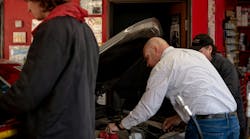When automakers don’t get it right, they really, don’t get it right. From small interior tidbits to catastrophic mechanical failures, these are the ten worst automotive design flaws that our readers have experienced.
10.) Rust Prone Brake Rotor Hardware
It makes sense. Automakers don’t want brake rotors falling off their cars. That would make for a messy situation. But there are ways that we can take both safety and ease of wrench into account when designing brake rotors.
I have actually owned cars where I have just given up on replacing the rotors after stripping the rusted out hardware. It’s a huge pain. Please, please stop this madness.
9.) Subaru EJ Head Gaskets
Looking into an older, high mileage Subaru as a winter beater? You better make sure that it has had its head gaskets replaced already. These older boxer-four motors blew head gaskets like it was its job. Especially those GC and GM bodied 2.5RS. Those were just awful.
8.) Audi GPS Controls/Cupholder
Why yes, it is a great idea to put the liquid beverage holder right next to an array of sensitive electronics! No! No! No!
It’s like the Audi designers realized they needed to put the GPS controls somewhere, so as an afterthought, they just deleted an ashtray and dropped them in there.
7.) Reyonnah Steering Wheel Placement
It’s one thing to have the steering wheel placed at an almost completely horizontal angle, but covering half of it underneath the dashboard makes it all the more awful for the driver.
It’s like a li’l tiny bus! But worse.
6.) Lincoln MKC Start/Stop Button
“Oh, you wanted to engage Sport mode but your finger slipped and you shut your car off while in-motion? Sorry!” Is what I imagine Lincoln’s interior designers said after crafting this incredibly flawed engine start/stop button for the MKC.
Because of the potential dangers associated with shutting the car off at speed, Lincoln was forced to issue a recall and move the button.
5.) Nissan GT-R Launch Control Transmission Failures
It sucks when you have a car that’s designed to go fast, but when you try and drive it fast, it breaks. And when it breaks, the automaker refuses to cover it under warranty. That’s how the owners of the early Nissan GT-Rs felt when their transmissions began to turn to mush after they tried launch control a couple of times and Nissan denied them coverage.
That all changed when GT-R owners came together and sued the hell out of Nissan.
4.) Alfa Romeo Busso V6 Timing Belt
Imagine living in fear every time you leave your manual transmission car parked on a steep hill, with the thoughts that your motor could potentially eat itself if your handbrake fails. Not so good, eh?
Thanks to this V6’s poorly designed timing system, that scenario has been a reality for many Alfa Romeo owners. Because the timing belts were short, weak, and came out of tension easily, these engines were prone to rebuilds from early on.
3.) Porsche IMS Bearings
Aside from those droopy headlights, this right here is one of the prime reasons why you can find 996s and early Boxsters for so damn cheap. No one wants to deal with the potentially catastrophic engine failures. Reader burglar can’t heart click anything can explain.
All Boxsters / Caymans / 911s from 1999-2008 (except the turbo and GT3 models) had some version of this. The cams are driven off of an intermediate shaft, and instead of a pressure fed oil bearing like in older motors Porsche used a sealed ball bearing.
Worked fine if a car was regularly driven preferably hard, and maintained on schedule. But if a car sat, or oil temps didn’t get nice and hot on occasion, corrosion would start to form and they’d eat themselves. Which would drop timing chains, and the whole motor would melt down. Very rare problem, but happened.
Porsche in their infinite wisdom went to a weaker smaller bearing in 2000, which failed much more easily.
They left it like that until 2006, where they went to the final solution - a slightly larger bearing that could no longer be serviced.
In 2009 they removed IMS bearing completely with the 9A1 motor redesign.
2.) VW Fox Rear Seat Finger Slicer
Moving those backseats back and forth and folding them up and down always gives me some sort of anxiety. It makes me feel like something is going to crawl out from under there and bite me. I just never thought that it would be the seat mechanism itself. When VW began seeing reports that the Fox was doubling as a finger-amputator, they were forced to step in and fix their flawed design.
1.) Audi TT Rear Aero
After at least five deaths were confirmed to be caused by the early Audi TT’s lack of rear-end stability, Audi was forced to scramble for mechanical fixes that would both put consumers at ease and give the car the performance it deserved. Early fixes involved redesigned rear-end suspension bits and a strategically designed spoiler. On top of those modifications that were covered under a recall, Audi also marketed an early electronic stability control system which vastly lowered the likelihood of some unexpected owner losing control at speed.
Though the problem was mainly prominent in the European market, where highway speeds are generally higher and driving maneuvers are faster-paced, the controversy affected Audi globally.
This article originally appeared on Jalopnik.




